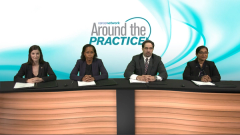
BCMA Bispecific T-Cell Engagers in the Treatment of MM
Nausheen Ahmed, MD, gives an overview of BCMA bispecific T-cell engagers used in the treatment of multiple myeloma.
Episodes in this series

Transcript:
Al-Ola Abdallah, MD: Nausheen, many BCMA BiTES [bispecific T-cell engagers] are coming out, and there are other targeted therapies that Dr Leyla [Shune] told us about. Can you talk about some of these drugs, like talquetamab and cevostamab?
Nausheen Ahmed, MD: These are promising therapies coming out. Once we start using these BCMA therapies and seeing resistance to BCMA-directed therapies, then these are other targets. For example, we have talquetamab, which is a bispecific that targets GPRC5D. Then there’s cevostamab, which is another bispecific targeting FCRH5. These are alternative targets on myeloma cells. [They’re] very good to have, especially if the patient has progressed on BCMA therapy, bispecifics, and BiTES. The studies for these drugs included patients who failed the BCMA CARs [chimeric antigen receptors], and there was a good response rate. There’s also a Regeneron product that’s also promising.
The interesting thing about these products is the adverse effects. We have some experience with these products and GPRC5D, which is a target that’s also found in skin, nails, and others. Obviously we’re aware that patients might have skin and nail changes. In our experience, there has been the dysphagia, which alters taste, so patients don’t want to eat much, and they lose weight. That may affect quality of life. There’s a lot more that we’re going to learn about these drugs as they come out.
Al-Ola Abdallah, MD: Looking at these, BCMA-targeted therapy is going to be our standard of care for triple-refractory [patients]. If the patient got BCMA CAR T cells, our case was that we have teclistamab, so that’s why we use it there. Would you prefer to use teclistamab or a different targeted bispecific if you had the chance to have another 1? A lot of individuals have information. I have my own opinion.
Nausheen Ahmed, MD: I don’t know that we have all the data, but there are some data. For example, in the BCMA world, would we use a CAR or bispecific first if the patient was OK to use both? There are some data that if a CAR is used after a bispecific, efficacy of the CAR might be a little less. We don’t use it to bridge for that reason. But if they’re early relapse after a CAR and it might be resistance to BCMA, these are questions that we’re going to learn about. Would we use an alternative target vs someone who relapsed a year out from a BCMA CAR? Would we rechallenge with a BCMA CAR? The good news is that we’ve seen responses in BCMA after BCMA. It’s just a question of seeing how these things pan out. I think we’ll have many options.
Al-Ola Abdallah, MD: I agree. If I saw a patient who got CAR T and responded really well for a year or 2, I’d prefer to use a BCMA bispecific. Maybe I’m a little biased saying maybe this patient [can still halfway] respond. If they’re refractory, I might question why I’m using a bispecific BCMA. I’d try to use another target therapy.
Transcript edited for clarity.
Newsletter
Stay up to date on recent advances in the multidisciplinary approach to cancer.



















































































